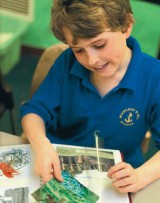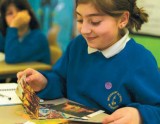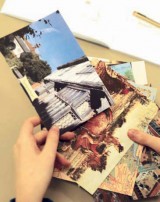Mike Askew’s postcard collection helps children to crack division...
Division, notoriously, is regarded as the most difficult of the four operations. I think this is a consequence of children thinking of division only as ‘sharing’ and not appreciating that it can also be ‘repeated subtraction’. Interpreting a division calculation in either of these ways is key to working flexibly and, later on, in dividing fractions. For example, many children think the calculation 12 ÷ 1/2 is impossible due to reading ÷ as ‘sharing’ - how can you possibly share between a half? Recognising that 12 ÷ 1/2 can be interpreted as repeated subtraction and ‘read’ as ‘how many 1/2s can you subtract from 12’ leads to the correct answer of 24.
 I take in postcards that I’ve collected over the years. Many of these are reproductions of famous works of art, so we spend a bit of time looking at and talking about these.
I take in postcards that I’ve collected over the years. Many of these are reproductions of famous works of art, so we spend a bit of time looking at and talking about these.
“Clearing out my cupboards at the weekend, I thought that it was time to sort out my postcard collection, which was in a mess in a shoebox. I’ve decided to put my collection into an album. I have 136 of these cards and I’m going to put 8 on each page of the album. So the problem I want us to work on is, how many pages of the album will I fill up?”
I ask children to turn to the person next to them and talk through the problem. I then invite individuals to explain the problem back to the class in their own words. I make it clear that I’m not yet interested in how they are going to try and figure out the answer. I jot down on the board the fact that there are 136 postcards and I want 8 to a page.
“I also want to organise my collection of postcards of views, but not in an album. I’m going to put the postcards into envelopes and I’m going to put the same number of postcards into each envelope. Spookily, when I counted the number of view postcards that I have, there are also 136. I’ve got 8 envelopes. So my other problem is, how many postcards will I put in each envelope?”
Again children talk in pairs to agree on what the problem is and I check this back with the whole class, noting on the board that there are 8 envelopes and another 136 postcards. If anyone points out that the answers to the two problems are going to be the same, I simply note that this is an interesting observation and we will see if that is the case when we come to look at the answers later. Most children do not immediately realise that these are, in essence, the same pair of calculations and I want them to come to that realisation through working on the problems.
“You can work on either problem first, so turn to your partner and agree on which problem you are going to work on and talk about how you will go about it.”
 I wander round checking that everyone is clear about the problems and then simply watch how the children approach it. There are usually a variety of methods and most of these involve addition or subtraction rather than formal division. For example, working on the album problem, children will add up 8s or multiples of 8 until they reach a total of 136 or subtract 8s from 136. I choose a pair to work with to show them how they might organise their work into a T-table to keep track of what is going on.
I wander round checking that everyone is clear about the problems and then simply watch how the children approach it. There are usually a variety of methods and most of these involve addition or subtraction rather than formal division. For example, working on the album problem, children will add up 8s or multiples of 8 until they reach a total of 136 or subtract 8s from 136. I choose a pair to work with to show them how they might organise their work into a T-table to keep track of what is going on.
| Pages | Postcards |
|---|---|
| 1 | 18 |
| 2 | 16 |
“What shall we have for the next number of pages?”
Children usually want to go to three pages next. I point out that that would work, but it could take a long time to get to 136 in the ‘postcards’ column. If they don’t suggest it themselves,
I ask if we could go to 4 pages and miss out 3? We fill this in and discuss how doubling the number of pages will double the number of postcards. Going to 8 pages is now relatively straightforward.
| Pages | Postcards |
|---|---|
| 1 | 8 |
| 2 | 16 |
| 4 | 32 |
| 8 | 64 |
I leave the children to carry on; with the invitation to come and find me when they get the answer or if they get stuck. What usually happens is that they get locked into a doubling strategy and get stuck when they ‘overshoot’ 136.
| Pages | Postcards |
|---|---|
| 1 | 8 |
| 2 | 16 |
| 4 | 32 |
| 8 | 64 |
| 16 | 128 |
| 32 | 256 |
I work with them on working from the highest number below 136 (128 postcards on 16 pages). We discuss the need for one more page and rework the table.
| Pages | Postcards |
|---|---|
| 1 | 8 |
| 2 | 16 |
| 4 | 32 |
| 16 | 128 |
| 17 | 136 |
I tell these children that, in a moment, I’m going to be gathering the class back together and they are going to share what they have been doing with everyone.
 With everyone together, I get the children who worked on building up the T-table to reconstruct this and share the method. I encourage the class to ask questions until they are clear about how the table is constructed. Then we look at ways of building it up other than through doubling, say by multiplying by ten and then halving, before adding the two results together.
With everyone together, I get the children who worked on building up the T-table to reconstruct this and share the method. I encourage the class to ask questions until they are clear about how the table is constructed. Then we look at ways of building it up other than through doubling, say by multiplying by ten and then halving, before adding the two results together.
| Pages | Postcards |
|---|---|
| 1 | 8 |
| 10 | 80 |
| 5 | 40 |
| 15 | 120 |
| 17 | 136 |
We then turn our attention to the other problem and I put up an empty T-table to start to represent this.
| Envelopes | Postcards |
|---|---|
| - | - |
“Turn to your partner. What information can we fill in on this table?”
It may not be obvious to the children how to put the information into this table as there are 136 postcards to be put into 8 envelopes and this is requires working ‘bottom up’ rather than top down:
| Envelopes | Postcards |
|---|---|
| 8 | 136 |
The missing information that we want is how many postcards will be put into 1 envelope so this can be filled in the row above:
| Envelopes | Postcards |
|---|---|
| 1 | ? |
| 8 | 136 |
Paired work – session 2
I set the children off again to find a way of filling in this table. If they don’t see how to do this I help them to work up from the bottom of the table using a halving strategy
| Envelopes | Postcards |
|---|---|
| 1 | 17 |
| 2 | 34 |
| 4 | 68 |
| 8 | 136 |
Having shared the solutions to the second problem, I put two reduced versions of the tables on the board:
| Pages | Postcards |
|---|---|
| 1 | 8 |
| 17 | 136 |
| Envelopes | Postcards |
|---|---|
| 1 | 17 |
| 8 | 136 |
We discuss how the numbers in each table are the same but ordered differently and that each problem can be represented by the calculation 136 ÷ 8 = 17.
“In the album problem we knew how many postcards to put on each page, but not how many pages we would fill. This is division as repeated subtraction. In the envelope problem we knew how many envelopes we had but not how many postcards were going to be put in each envelope. This is division as sharing.”
 Mike Askew is professor of mathematics education at King’s College London and a freelance primary maths consultant. For further information on his work see http://www.mikeaskew.net
Mike Askew is professor of mathematics education at King’s College London and a freelance primary maths consultant. For further information on his work see http://www.mikeaskew.net
Teaching five year olds to talk
Ace-Classroom-Support
How to use modelling to engage pupils with autism
Ace-Art-And-Design
